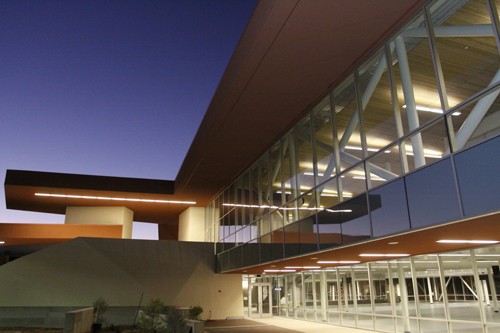The Student Recreation Expansion is poised to become the first university building in the nation to reach the highest level of sustainability certification by the U.S. Green Building Council.
The U.S. Green Building Council uses the Leadership in Energy and Environmental Design, also known as LEED, rating system to give newly constructed building points based on sustainable design features. Buildings are awarded silver, gold or platinum certification, depending on the number of points awarded.
The Student Recreation Expansion has earned enough points to become gold certified, but is one point away from receiving platinum certification, said Juliette Moore, director of Campus Recreation.
LEED certification awards points in six different categories of sustainable design: sustainable site, water efficiency, energy and atmosphere, materials and resources, indoor environment quality, and innovation and design, said Tim Stevens, a design architect for the project.
“”We’re pretty strong in every single one of those categories,”” Stevens said.
According to the university’s Planning, Design and Construction Web site, the Student Recreation Expansion will use water harvesting, local concrete and concrete masonry products, and recycled building materials which will divert more than 75 percent of construction waste from landfills. The building will also control daylight in order to conserve energy.
“”It is a building that is very much suited to its environment in a sense that all the harsh solar exposures are protected from the sun,”” Stevens said. “”There’s a lot of passive solar strategies just in terms of how we use deep overhangs to protect the south side … The spaces are well-lit, so that during the day we don’t have to turn on the lights if we don’t want to.””
Because student fees fund the building construction, the sustainable design was also viewed as a way to save money, Stevens said.
“”One of the main goals behind this project was shepherding the use of the students’ money, so over a long term, the more sustainable approach you take, the less cost over time the building takes in terms of operation and maintenance,”” he said.
Though the building is on-track to reach platinum certification, the original goal was only to reach silver, Stevens said.
“”When we were meeting with all the building stakeholders in the building committee, one of the goals that came out of it was that we wanted the building to express some of these sustainable initiatives, and so from the earliest concept design, we were integrating a lot of the sustainable design strategies into the way the building looked and the way the building was organized,”” he said. “”Because of that, we realized about halfway through the process that silver was not a very aggressive target at all and we essentially could have achieved silver without trying.””
The Student Recreation Expansion would be the first UA building to obtain gold or platinum certification and the first university building in the nation to obtain platinum. It would be the fifth building in Tucson to obtain platinum certification, Moore said.
Student input played a major role in the building design moving toward platinum certification, Stevens said.
“”For a building that was essentially funded with students’ money, it made a lot of sense to articulate those types of ideals in the building and achieve as high a rating as we possible can,”” Stevens said.









